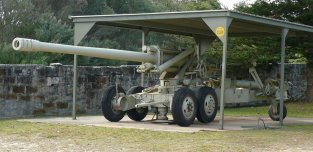
ARTILLERY REGISTER |
|||||||||||||||||||||||||
|
|
||||||||||||||||||||||||
| Historical Specifics: | South Africa realised the need for modern artillery when they came up against Cuban Forces, armed with Soviet equipment, in Angola in 1974. Simply the Russian guns easily out ranged the old British guns used by the South Africans. Determined to modernise they sought assistance but were heavily hampered by the UN Anti apartheid Sanctions.
Dr Gerald Bull, a Canadian, had been working on long range artillery shells and a gun the GC 45. In 1977 he came into contact with a South African Arms manufacturer who produced improvements to the design of the gun. Bull was arrested by the US in 1980 and sentenced to 12 months of which he served 6. Upon release he set up operations in Brussels. Meanwhile the South Africans continued their work on developing the gun and in 1982 they put it into service as the GC 5. Its range was far superior to any other weapon of its type. They saw service in the Angolan war and soon dominated. |
||||||||||||||||||||||||
| General Information on Gun Type: | |||||||||||||||||||||||||
| Additional Photos: | |||||||||||||||||||||||||
